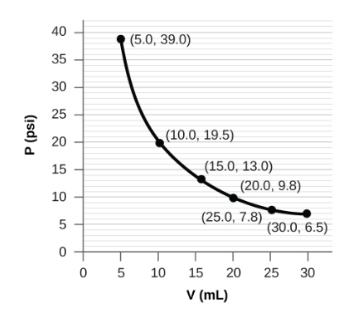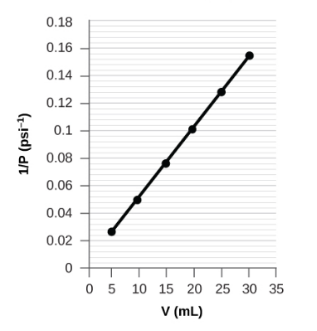40 (5.0, 39.0) 35 - 35 10 30 - 40- 25 20 - (10.0, 19.5) (15.0, 13.0) (20.0, 9.8) 15 - 10 (25.0, 7.8) (30.0, 6.5) 10 T 10 15 20 25 30 15 V (mL) 20 0.18 25 0.16 - 30 mL/cc 0.14 0.12 0.1 0.08 - 0.06 0.04 0.02 0 5 10 15 20 25 30 35 V (mL) Figure 9.13 When a gas occupies a smaller volume, it exerts a higher pressure; when it occupies a larger volume, it exerts a lower pressure (assuming the amount of gas and the temperature do not change). Since P and V are inversely proportional, a graph of vs. V is linear. 1/P (psi-) P (psi)
40 (5.0, 39.0) 35 - 35 10 30 - 40- 25 20 - (10.0, 19.5) (15.0, 13.0) (20.0, 9.8) 15 - 10 (25.0, 7.8) (30.0, 6.5) 10 T 10 15 20 25 30 15 V (mL) 20 0.18 25 0.16 - 30 mL/cc 0.14 0.12 0.1 0.08 - 0.06 0.04 0.02 0 5 10 15 20 25 30 35 V (mL) Figure 9.13 When a gas occupies a smaller volume, it exerts a higher pressure; when it occupies a larger volume, it exerts a lower pressure (assuming the amount of gas and the temperature do not change). Since P and V are inversely proportional, a graph of vs. V is linear. 1/P (psi-) P (psi)
Chemistry
10th Edition
ISBN:9781305957404
Author:Steven S. Zumdahl, Susan A. Zumdahl, Donald J. DeCoste
Publisher:Steven S. Zumdahl, Susan A. Zumdahl, Donald J. DeCoste
Chapter1: Chemical Foundations
Section: Chapter Questions
Problem 1RQ: Define and explain the differences between the following terms. a. law and theory b. theory and...
Related questions
Question
How would the graph as shown change if the number of moles of gas in the sample used to determine the curve were doubled?

Transcribed Image Text:40
(5.0, 39.0)
35 -
35
10
30 -
40-
25
20 -
(10.0, 19.5)
(15.0, 13.0)
(20.0, 9.8)
15 -
10
(25.0, 7.8)
(30.0, 6.5)
10
T
10
15
20
25
30
15
V (mL)
20
0.18
25
0.16 -
30
mL/cc
0.14
0.12
0.1
0.08 -
0.06
0.04
0.02
0 5
10 15 20 25 30 35
V (mL)
Figure 9.13 When a gas occupies a smaller volume, it exerts a higher pressure; when it occupies a larger volume, it
exerts a lower pressure (assuming the amount of gas and the temperature do not change). Since P and V are
inversely proportional, a graph of vs. V is linear.
1/P (psi-)
P (psi)
Expert Solution
Step 1
The Boyle’s law describe the relation of gas’s pressure with its volume at constant temperature and constant mol of gas.
According to this law the volume and pressure of the gas are inversely proportional to the each other keeping mole of gas and temperature constant; this relation can be expressed as follows:

Here, V is volume of gas and P is the pressure of gas.
PV = constant [T, n fixed]
Step 2
The graph is:


Step by step
Solved in 3 steps with 3 images

Knowledge Booster
Learn more about
Need a deep-dive on the concept behind this application? Look no further. Learn more about this topic, chemistry and related others by exploring similar questions and additional content below.Recommended textbooks for you

Chemistry
Chemistry
ISBN:
9781305957404
Author:
Steven S. Zumdahl, Susan A. Zumdahl, Donald J. DeCoste
Publisher:
Cengage Learning

Chemistry
Chemistry
ISBN:
9781259911156
Author:
Raymond Chang Dr., Jason Overby Professor
Publisher:
McGraw-Hill Education

Principles of Instrumental Analysis
Chemistry
ISBN:
9781305577213
Author:
Douglas A. Skoog, F. James Holler, Stanley R. Crouch
Publisher:
Cengage Learning

Chemistry
Chemistry
ISBN:
9781305957404
Author:
Steven S. Zumdahl, Susan A. Zumdahl, Donald J. DeCoste
Publisher:
Cengage Learning

Chemistry
Chemistry
ISBN:
9781259911156
Author:
Raymond Chang Dr., Jason Overby Professor
Publisher:
McGraw-Hill Education

Principles of Instrumental Analysis
Chemistry
ISBN:
9781305577213
Author:
Douglas A. Skoog, F. James Holler, Stanley R. Crouch
Publisher:
Cengage Learning

Organic Chemistry
Chemistry
ISBN:
9780078021558
Author:
Janice Gorzynski Smith Dr.
Publisher:
McGraw-Hill Education

Chemistry: Principles and Reactions
Chemistry
ISBN:
9781305079373
Author:
William L. Masterton, Cecile N. Hurley
Publisher:
Cengage Learning

Elementary Principles of Chemical Processes, Bind…
Chemistry
ISBN:
9781118431221
Author:
Richard M. Felder, Ronald W. Rousseau, Lisa G. Bullard
Publisher:
WILEY